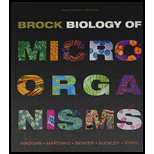
Brock Biology of Microorganisms, MasteringMicrobiology with eText and Access Card (14th Edition)
14th Edition
ISBN: 9780133857276
Author: Michael Madigan
Publisher: PEARSON
expand_more
expand_more
format_list_bulleted
Concept explainers
Question
Chapter 17.15, Problem 2MQ
Summary Introduction
Galdieria belongs to a group of unicellular red algae and is an important genus of the Cyanidiales group. It can survive in extreme harsh environment in which no other phototrophic organism can survive. These organisms are mostly found in hot springs which are rich in acid and metal ions.
Expert Solution & Answer
Want to see the full answer?
Check out a sample textbook solution
Students have asked these similar questions
What is physiologically unusual about thethaumarchaeotal species Nitrosopumilus maritimus?
Paramecia that live in freshwater have contractile vacuoles, while those that live in salt water do not. why is that the case?
What is thalloid body of a slime mould (Myxomycetes) is known as?
Chapter 17 Solutions
Brock Biology of Microorganisms, MasteringMicrobiology with eText and Access Card (14th Edition)
Ch. 17.1 - Prob. 1MQCh. 17.1 - Prob. 2MQCh. 17.1 - Prob. 3MQCh. 17.2 - Prob. 1MQCh. 17.2 - Prob. 2MQCh. 17.2 - Prob. 3MQCh. 17.3 - Prob. 1MQCh. 17.3 - Prob. 2MQCh. 17.4 - Contrast the two nutritional options for Euglena.Ch. 17.4 - Prob. 2MQ
Ch. 17.4 - Prob. 3MQCh. 17.5 - Prob. 1MQCh. 17.5 - Prob. 2MQCh. 17.5 - What are apicoplasts, which organisms have them,...Ch. 17.6 - Prob. 1MQCh. 17.6 - Prob. 2MQCh. 17.6 - Prob. 3MQCh. 17.7 - Prob. 1MQCh. 17.7 - How are chlorarachniophytes thought to have...Ch. 17.8 - Prob. 1MQCh. 17.8 - Compare and contrast the lifestyles of gymnamoebas...Ch. 17.8 - Prob. 3MQCh. 17.9 - What are conidia? How does a conidium differ from...Ch. 17.9 - Prob. 2MQCh. 17.9 - Prob. 3MQCh. 17.10 - Why is the mold Penicillium economically...Ch. 17.10 - Prob. 2MQCh. 17.10 - Prob. 3MQCh. 17.11 - Prob. 1MQCh. 17.11 - Prob. 2MQCh. 17.11 - Prob. 3MQCh. 17.12 - Prob. 1MQCh. 17.12 - Prob. 2MQCh. 17.12 - Prob. 3MQCh. 17.13 - Prob. 1MQCh. 17.13 - Prob. 2MQCh. 17.14 - Prob. 1MQCh. 17.14 - Prob. 2MQCh. 17.15 - What traits link cyanobacteria and red algae?Ch. 17.15 - Prob. 2MQCh. 17.16 - What phototrophic properties link green algae and...Ch. 17.16 - What is unusual about the green algae...Ch. 17.16 - Prob. 3MQCh. 17 - Prob. 1RQCh. 17 - Prob. 2RQCh. 17 - Prob. 3RQCh. 17 - Prob. 4RQCh. 17 - Prob. 5RQCh. 17 - Three groups make up the alveolates: ciliates,...Ch. 17 - Prob. 7RQCh. 17 - REVIEW QUESTIONS
8. What morphological trait...Ch. 17 - Prob. 9RQCh. 17 - Prob. 10RQCh. 17 - Prob. 11RQCh. 17 - Prob. 12RQCh. 17 - Prob. 13RQCh. 17 - Prob. 14RQCh. 17 - Prob. 15RQCh. 17 - Prob. 16RQCh. 17 - Green algae are common in aquatic environments and...Ch. 17 - Explain why the process of endosymbiosis can be...Ch. 17 - Summarize the evidence for endosymbiosis. How...
Knowledge Booster
Learn more about
Need a deep-dive on the concept behind this application? Look no further. Learn more about this topic, biology and related others by exploring similar questions and additional content below.Similar questions
- ➢ Is the tripartite body plan of phoronids advantageous for them? Why or why not? ➢ Why is the formation of actinotroch necessary for phoronids? ➢ What are the advantages of being colonial for bryozoans? What are its downside?arrow_forwardHow is the cell wall of Chlamydia highly unusual?arrow_forwardWhat is the life cycle of spirogyra, as well as its ecology and comparisons to Chlamydomonas?arrow_forward
- Which Prokaryotes Are Most Closely Related toMitochondria?arrow_forwardWhat is the ecological importance of coccolithophores?arrow_forwardIn Platyhelminthes, what are the advantages/disadvantages of being a parasite? Free living? Why is there an observed loss of organs and structures in parasitic species?arrow_forward
arrow_back_ios
arrow_forward_ios
Recommended textbooks for you


Chapter 5 Microbial Metabolism; Author: Heather Davis;https://www.youtube.com/watch?v=wH_HrsfDWZw;License: Standard Youtube License